Schedule: Monday – Friday, from 11.00-17.00, until 23.07.2023.
VENUE: HUB & Studio 2.0.
“Why Haven’t We Built a Dyson Sphere? Re-drawing the walls and fences that make up our home”
Participants: Laureta Hajrullahu, Majlinda Hoxha, Jakup Ferri, Rina Krasniqi, Atdhe Mulla, Brilant Pireva.
Curated by: Donjetë Murati.
Have you come across that meme with the image of flying vehicles, large futuristic buildings and a serene landscape with text that says something like “the world if phone batteries lasted longer”? The meme is funny because it imparts an outsized civilizational importance on a daily nuisance, but its weight comes from the fact that each of us can relate to a desire for a better world. Given that, we invite you to join us in a home environment to wonder about our current conditions and about what is keeping us from experiencing this futuristic serene landscape.
Through this exhibition we’d like you to consider the Dyson Sphere. A hypothetical mega structure surrounding the sun, the Dyson Sphere is meant to harness the power of the stars. Proposed by Freeman Dyson in the 1960s, the idea is to capture and utilize immense amounts of energy to support advanced civilizations that would be reliant on this level of energy. The construction of a Dyson Sphere would be an enormous undertaking that would require a vast amount of resources and advanced technology, and would supposedly enable human flourishing on a massive scale. At present, the construction of such a structure is well beyond our technological capabilities.
This astrophysics thought experiment is at the center of our installation because it prompts us to think about home outside of the picket fence and about how domestic emotions like love can extend beyond the four walls of the home.
When talking about space exploration people often talk of “colonizing” other planets or “exploiting” extraterrestrial resources across the universe. Even our most utopian ideas are framed in a language of violence and exploitation, they are stuck in our contemporary cultural reality. The sciences are not outside of these social relations, which we reproduce in every interaction. Perhaps it is necessary to shed these social relations that endanger and discriminate against so many — only then may a Dyson Sphere be possible. What is holding us back? Is it gender-based discrimination, our modes of production or economic inequality? How many new discoveries and social advancements do we miss out on due to severe poverty? What potential from our common collective imagination goes unrealized?
Recently there has been a rich exploration in Prishtina of the concept of “Home.” Last year alone we saw several interpretations. During Manifesta 14 Prishtina, with creative mediator Catherine Nichols, there were two notable interventions on the theme. “Sister Flats” by Alicja
Rogalska, a performative installation developed in collaboration with Kosovar feminist activists,
created a space to give free legal advice to local women while Alban Muja’s “Above Everyone” involved building a model home on top of the former Gërmia department store, which brought attention to the city’s architectural landscape and the future of public buildings. At the Gallery of the Ministry of Culture there was the exhibition “Space for Unmade Memories,” by the artist Luan Bajraktari and curated by Hana Halilaj, which transformed the gallery into a living room created from remnants of previous interiors, and the literary zine “Lirindja” has been collecting stories as of last year for their upcoming publication on Home.
Emotions like love are associated with home, but they are often limited to the select few within the family unit. Our homes are rarely considered the center of our political lives, yet they are the first place we interact with the world. Whether these relationships and social interactions are traumatic or soothing can decide the direction of future social interactions outside the family unit and the direction of social relations more broadly. Home is the starting point for reflection and change.
“Why Haven’t We Built a Dyson Sphere” asks that you join us in thinking about our current conditions, about the possibility for transformation and exploration, and how this might all start locally, at home. Perhaps a serene landscape and a secure livelihood for all is a precondition of creating utopian projects like the Dyson Sphere, and not the other way around.
We invite you to come and experience the art works, furniture, and immersive lectures that make up this intervention. Stemming from our relationship with other beings and species, to how we buy a piece of love, to the meaning of homes even when surroundings change, to speculative images, our installation is a home made for all of us to spend time together.
If you’d like to know more about the dyson sphere, several theories and discoveries taking place on a daily basis, do check out the following superb YouTube Channels and TikTok creators:
Tiktok creators
YouTube Channels
What if We Built a Dyson Sphere?
How to Build a Dyson Sphere – The Ultimate Megastructure
Jakup Ferri (born 1981, Pristina, Kosovo) is a contemporary artist based in Prishtina and Den Haag and is a professor at Prishtina Art Academy.
Ferri’s works are inspired by children’s drawings, folk art, and so-called Outsider Art. The paintings and embroideries are based on the artist’s (slightly) surreal drawings depicting everyday scenes involving animals, children, acrobats and utopian architecture.
The handwoven carpets with geometrical patterns, on the other hand, are based on the artist’s son’s avatar designs from the computer game Animal Crossing. Ferri, who collaborates with women from Albania, Kosovo, Burkina Faso and Suriname for his textile works, considers carpet making and embroidery as a technique of coherence and community building.
“Tintirinti” (2022), the hand-woven carpet presented in this exhibition, was commissioned for “The Monumentality of the Everyday,” an exhibition curated by Inke Arns, which represented Kosovo at the Venice Bienniale of Art in 2022.
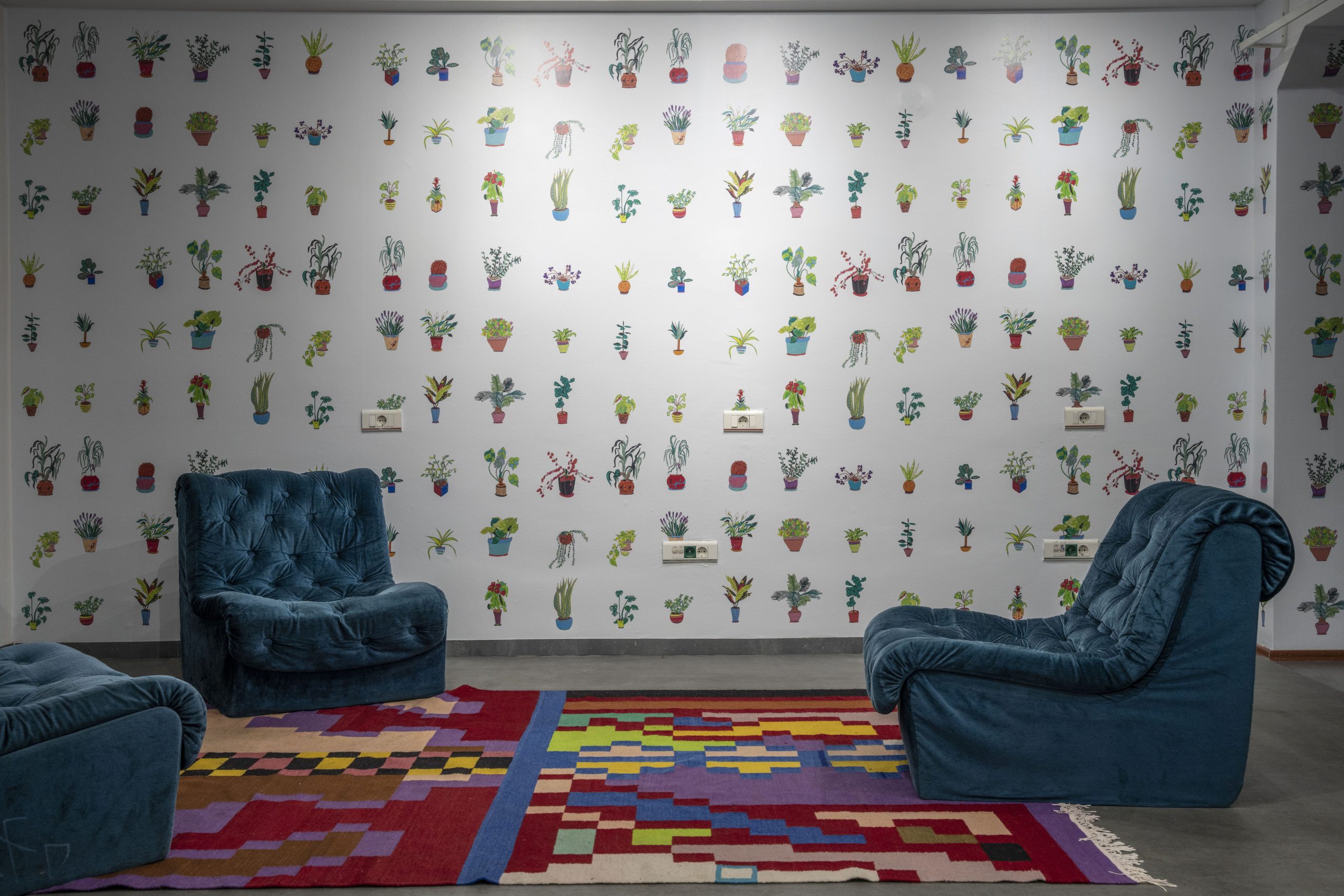
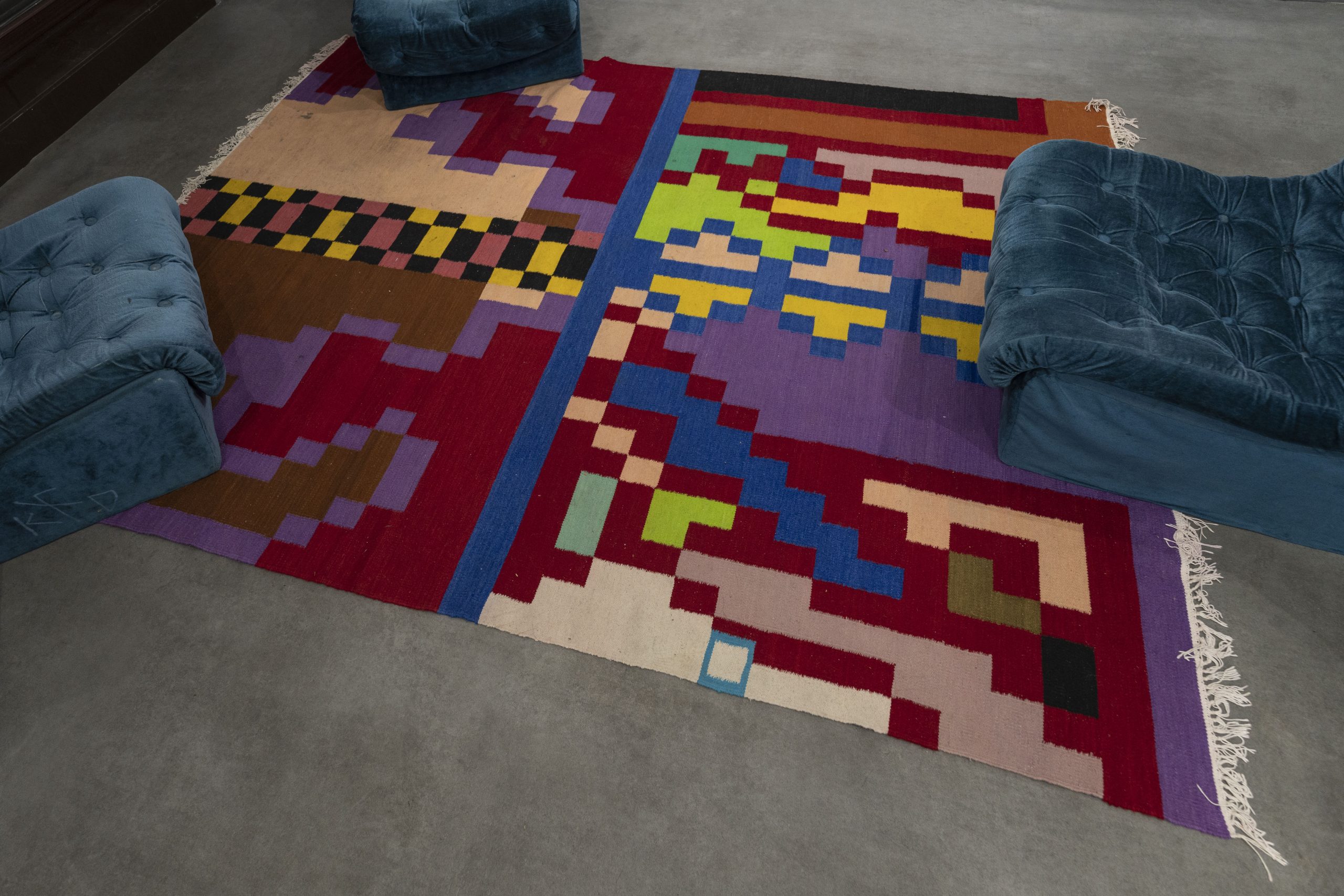
Laureta Hajrullahu (born 1997, Presheva, Serbia) is a Pristina-based multimedia artist. Her artistic work explores privacy, gender, intimacy, digital ecosystems, video games and impossible futures. Through her digital media work, she presents diverse, critically-informed views on “reality.” She does this by deconstructing and re-evaluating the boundaries between the virtual and physical world.
“Flowers of Monoxide, Expired Fairies” (2022) is a speculative work that imagines different beings and species. These species imagined by Laureta are having a party in this alternate dimension which is occupied by non-humans. When viewing these two textile sculptures, you’re invited to think about different dimensions and the creatures that may exist alongside us but which we can’t see. Part of this party — shown on an Mp4 player that Laureta has owned since she was a teen living in Presheva — includes a recording of the video game “Planet Laika,” in which the player’s purpose is to colonize Mars.
Through this, Laureta sets the stage for considering other life forms and species and our relationships with them. In learning about human kind, most school literature has pointed out that because humans have developed consciousness they are somehow superior to other life forms. A 1999 New York Times article by Stephen Jay Gould called “The Human Difference” argues that although the claim that only humans have consciousness has been disproved, our broader relationship to animals remains one of domination and exploitation. “Flowers of Monoxide, Expired Fairies” invites us to reconsider our relationship to other species, both the visible ones as well as the ones we might not see quite yet, and which are perhaps among us in the 11th dimension.
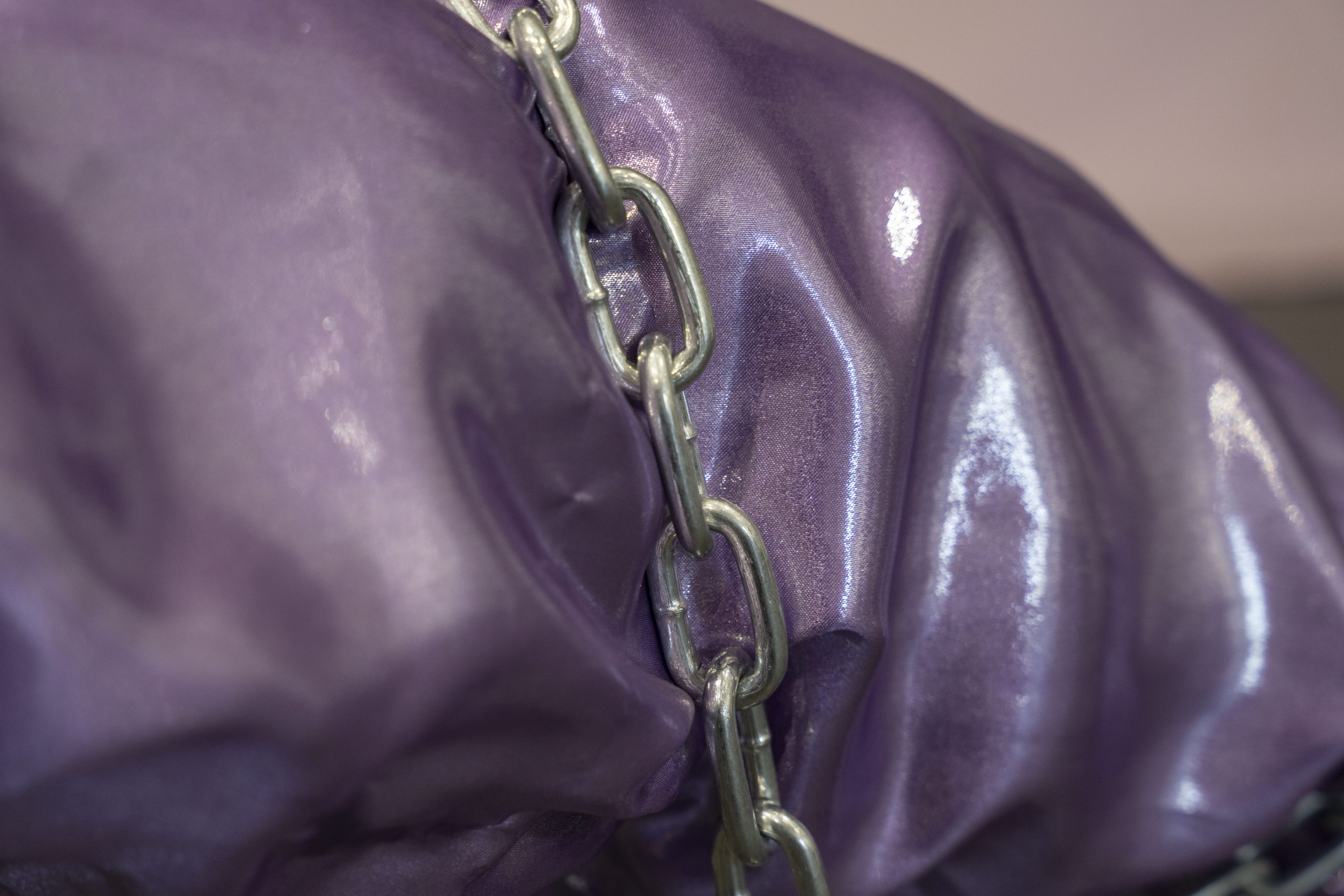

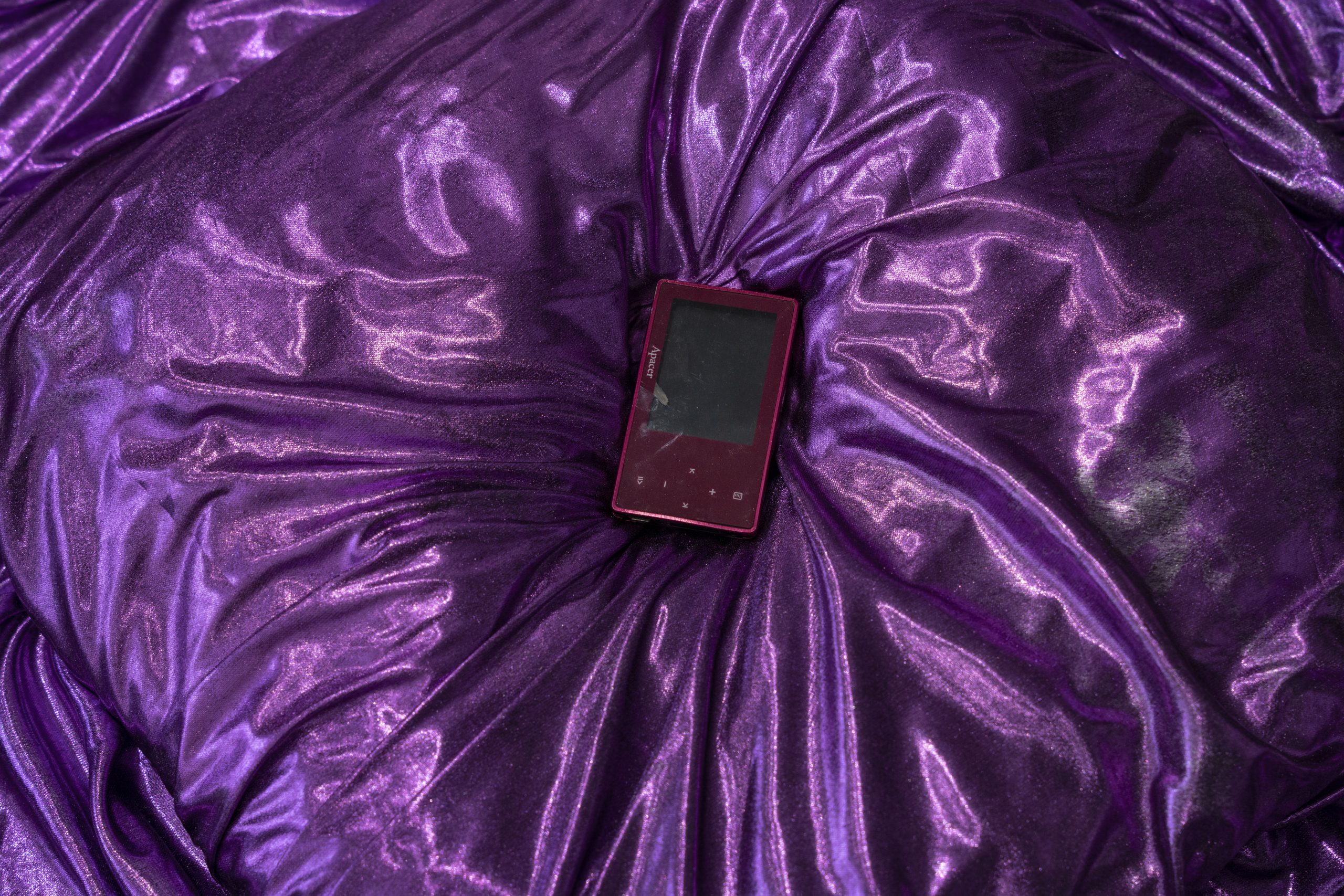

Majlinda Hoxha (born 1984, Kosovo) — is a Pristina-based photographer. She received her MFA from the Elam School of Fine Art at Auckland University, New Zealand in 2008. Hoxha’s photography draws on a language of fragmentation and displacement and is sensitive to the recent political and social upheaval of Kosovo. She is currently based in Prishtina, Kosovo, the source and foundation of most of her artistic work.
“Dive Pool” (2008) is a photo from Hoxha’s series “In the realm of uncanny.” The photo, taken in Aotearoa/New Zealand, presents a serene environment of a human-made structure, a swimming pool which imitates nature, across a backdrop of magnificent deep-rooted trees in Aotearoa. New Zealand became a part of Hoxha’s identity when she was forced to flee Kosovo during the war, leaving in 1999 in the first plane of refugees from Kosovo to New Zealand. The serene environment of New Zealand, which became a second home for Hoxha, is a nurtured and a highly protected space due to the rich culture of the Maori, who are indigenous to the land. Rāhui is a restricted area where the harvesting of resources is banned.
In the photo, a sign reads “Bombing Allowed,” which takes on opposing meanings from the perspectives of the two different homes, particularly in the context of 2008 when the photo was taken. As swimmers ball up like armadillos to “bomb” into the New Zealand pool, in 2008, back in Hoxha’s other home, people were reflecting on how the bombs of intervention had been welcomed to end the war in 1999.
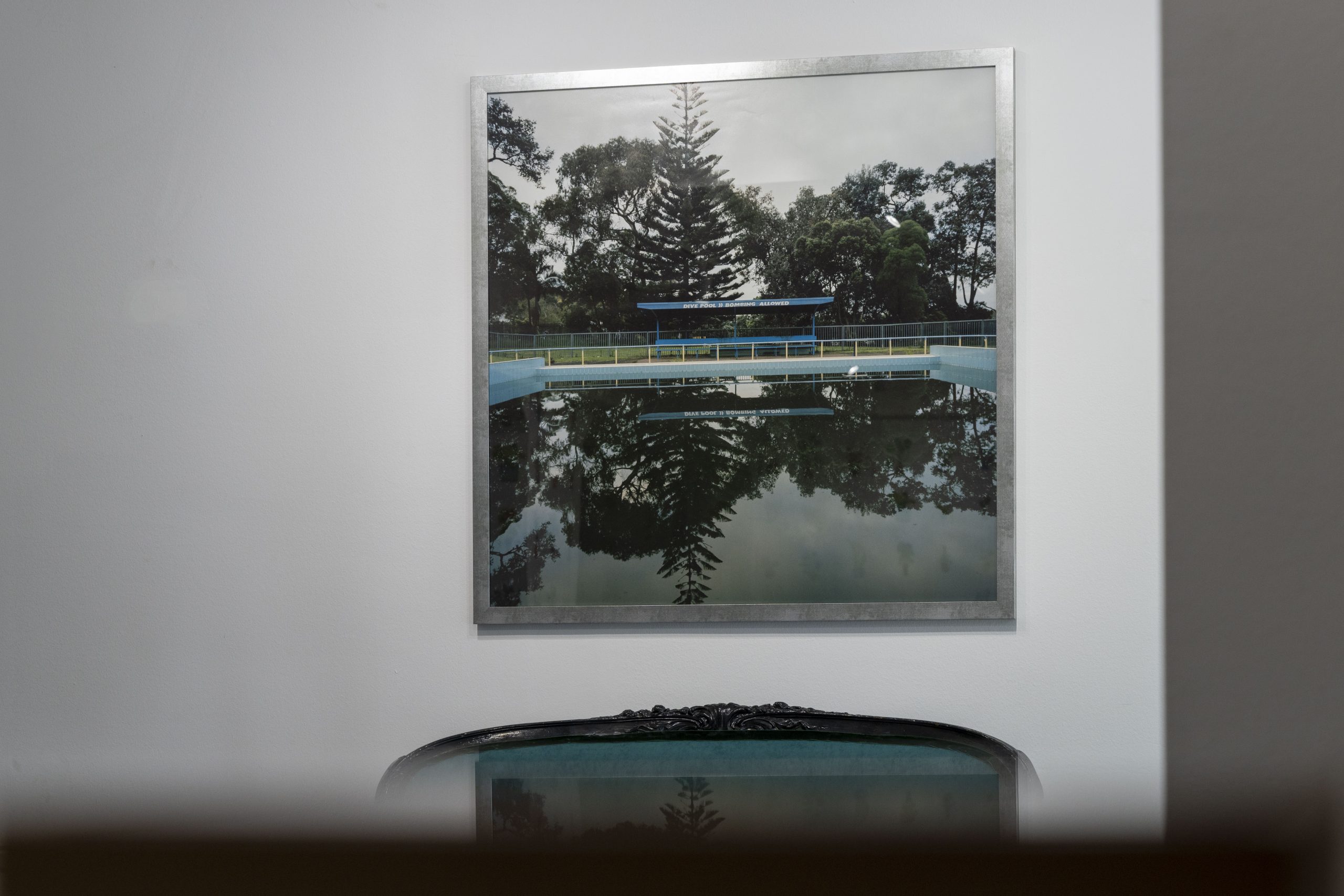

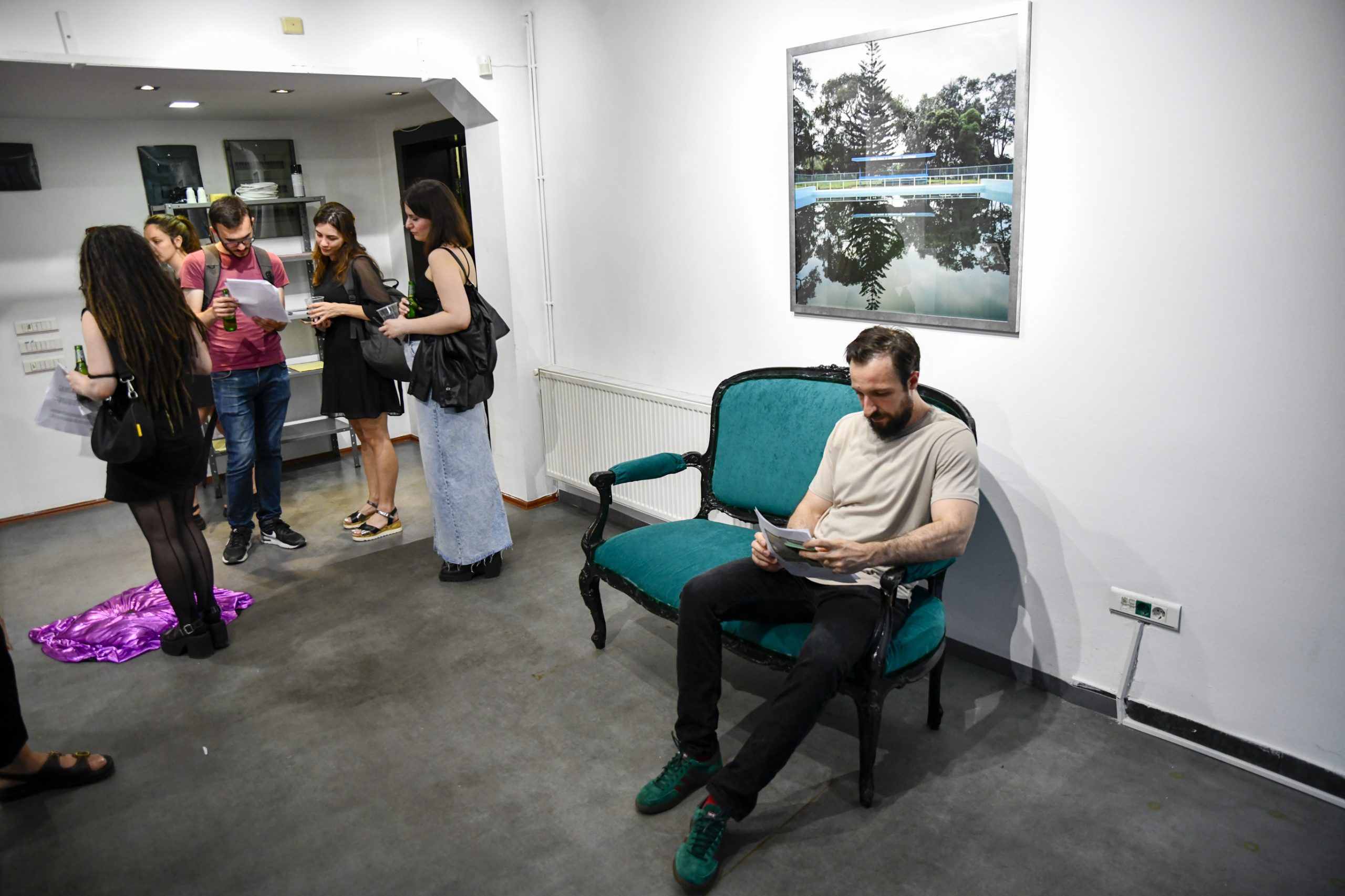
Rina Krasniqi (born 1988) is a writer and illustrator. Co-author of “BOOM 1982-1987” (2020) and “Pini Maca Ujë” (2023), and author of “Coloring Lumbardhi” (2022), she is the co-founder of Lirindja, a publishing house that started as an independent literary zine in Prishtina.
Rina Krasniqi presents two works in this exhibition: the drawing and zine “The Bush,” and a wallpaper. Krasniqi’s newly conceived work “30 Innocent plants standing between the troubled relationship between capitalism and me” is a wallpaper pattern consisting of 30 different plants, the selection of which was the result of research into common meanings associated with different plants.
The work investigates how capitalism determines our relationship to biodiversity and plant life. All plant life, and particularly the plants included in the wallpaper, seem to be given their meanings by people, whereas their acquisition and their presence in people’s lives is determined through our economic relations. The selected plants are common houseplants and represent peace, joy, good luck and money. Ranging from peace lilies to jade plants, they have all been taken from their native environments to grace people’s homes.
The drawing “The Bush,” alongside the zine telling the story of the bush, depicts a plant that Rina’s father, Mazllom Krasniqi has cared for and which is now cared for by the whole family including her mother Edibe, sister Edona and brother Ron. The Bush, as Rina refers to it, is of great sentimental value and source of joy for the entire family. But ensuring that it’s always cared for has also been a source of worry — as care and love always are. Sitting in front of the apartment building where Krasniqi grew up, the bush is part of the delightful relationship with the surrounding ecosystem that Rina’s father established.
Rina shows how these meanings are conjured up through our relationship to the commodification of everything.
Across the universe, precious stones and jewels are said to be present inside some asteroids and other extraterrestrial bodies. But, Rina’s work poses the question: what makes something precious outside capitalist relationships? In “Trees are more Valuable than diamonds!” content creator Astro Alexandra points out the uniqueness of our ecosystem. What hasn’t yet been found outside Earth is plant life. Despite advanced technology that can identify microwave radiation billions of light years away, we haven’t encountered anything remotely resembling trees. If we go beyond Earthly economic considerations, trees aren’t treasured nearly enough given their cosmic uniqueness. Though people like climate activists and some indigenous peoples have relationships to biodiversity that go beyond capitalist relations, for the most part forests and plant life are taken for granted and seen through the prism of profit.
Next time you’re walking across the city, look at your surroundings, especially the ground you walk upon. You might notice stems and leaves poking through the concrete or up through sewer covers, cosmically rare treasures, reaching for the sun.
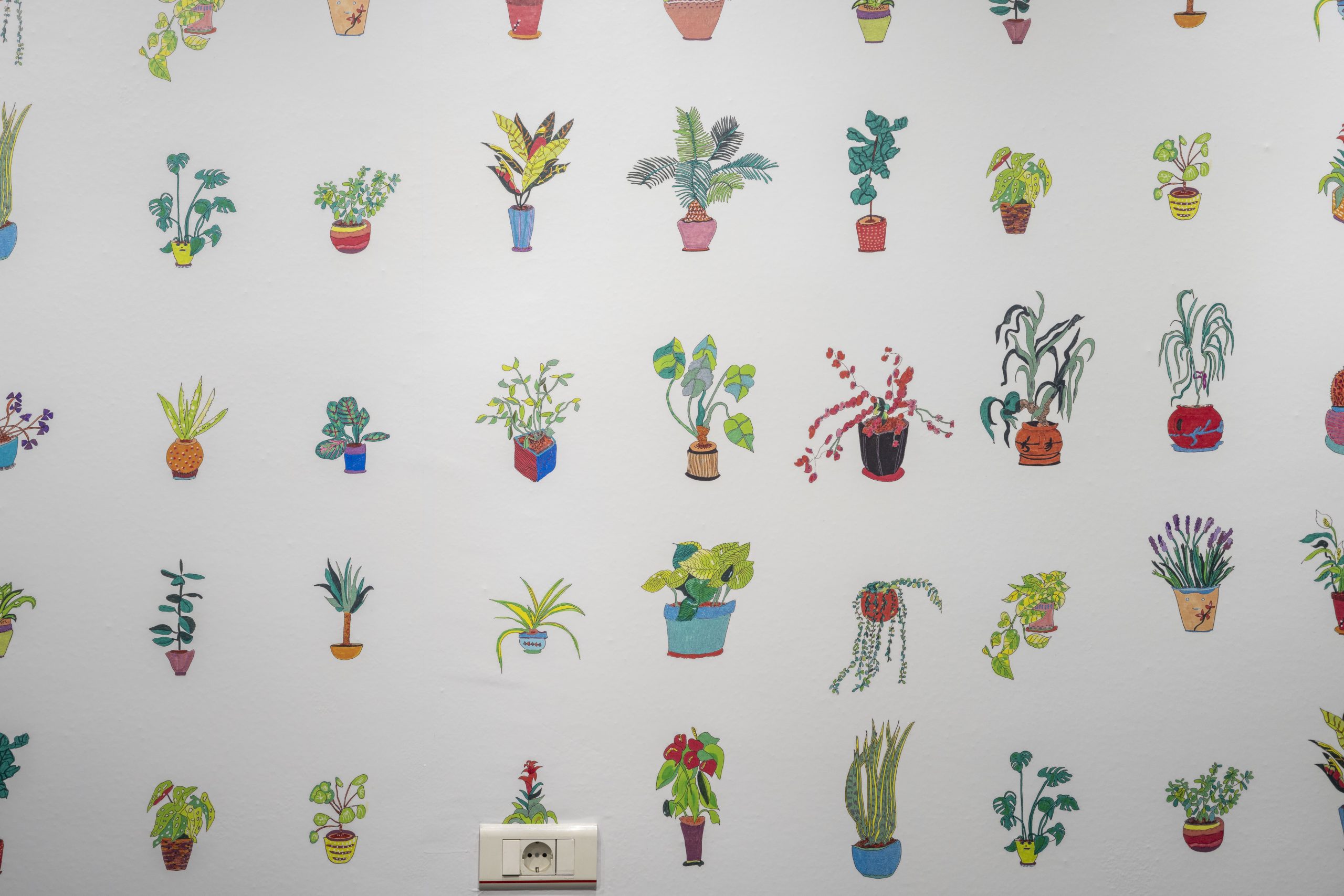
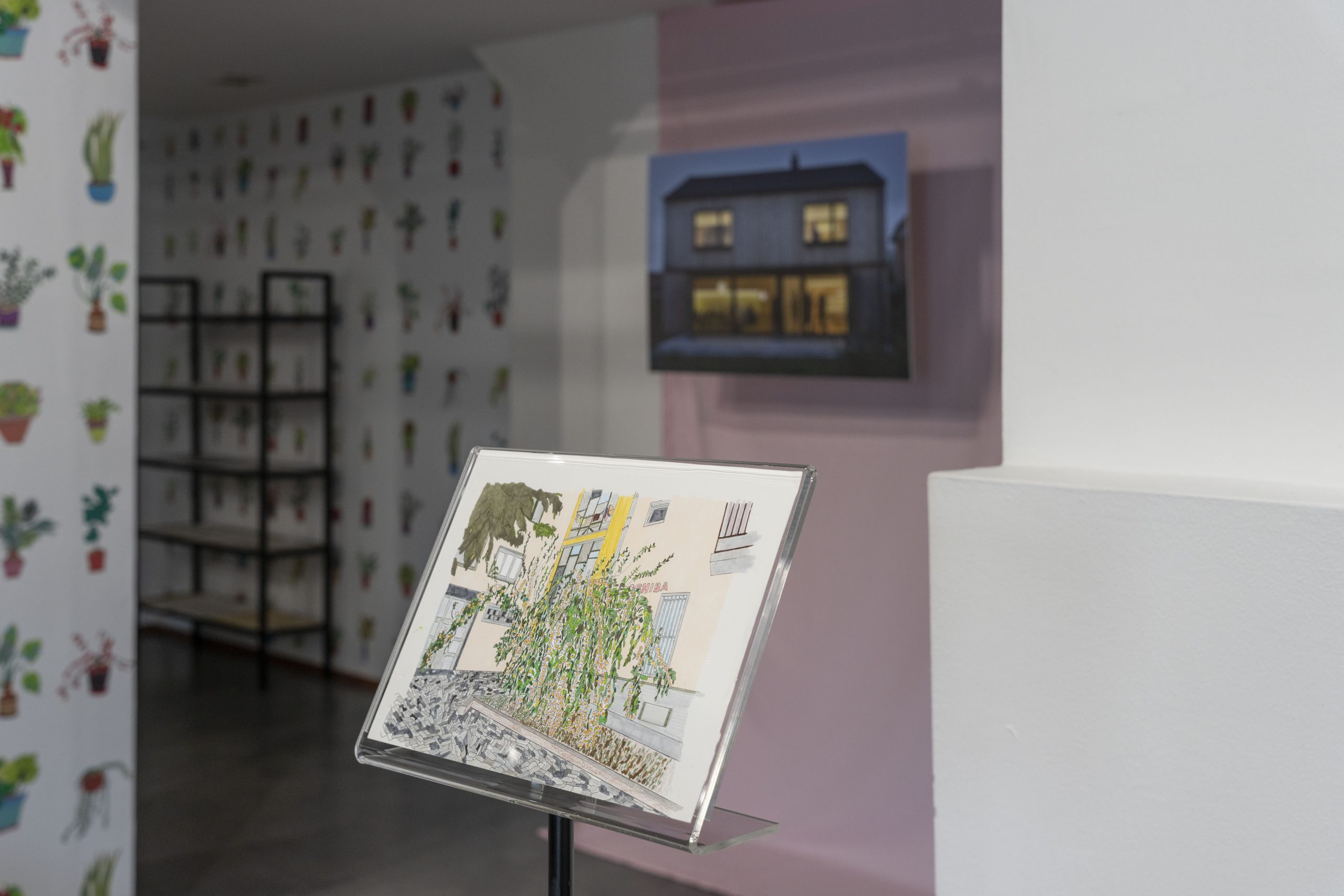

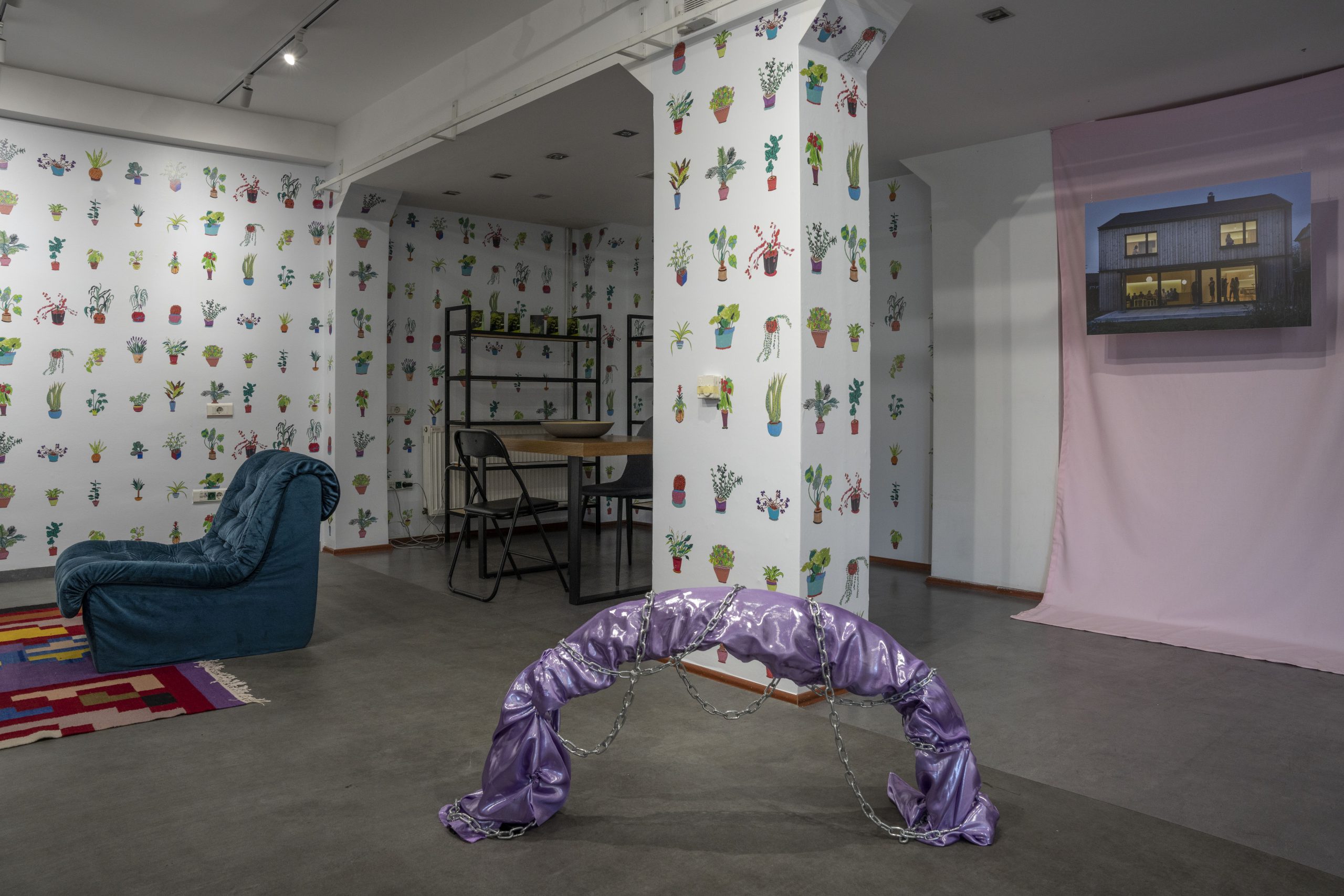
Atdhe Mulla (born 1984) is a photographer and photography editor at Kosovo 2.0. Atdhe has a bachelor’s degree in still photography from the Film and TV School of the Academy of Performing Arts in Prague, Czech Republic.
Atdhe Mulla’s photograph “Nexhi’s house from Germany” is a little house in the village Stanovc in Vushtrri. The house is located in the middle of other family houses. In this staged photograph, after six hours of spending time together, Mulla captured the spirit of the diaspora and the feeling of returning home to build a house. You can spot other relatives of Nexhi’s in the image coming together. The longing to return home and build a modern structure is a common feature in the architecture landscape in Kosovo. Furthermore, the photo beautifully captures a fleeting moment of coming together.
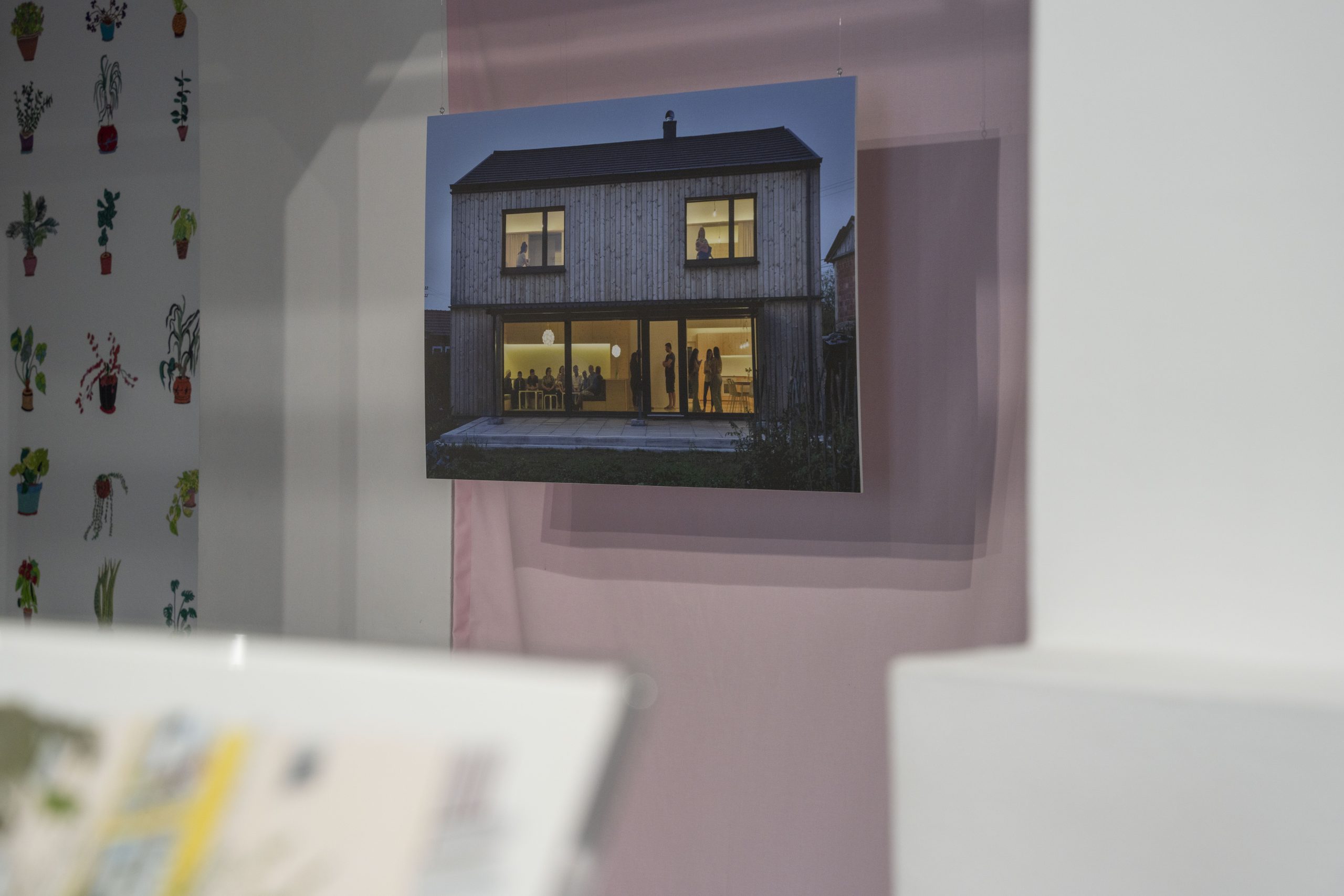
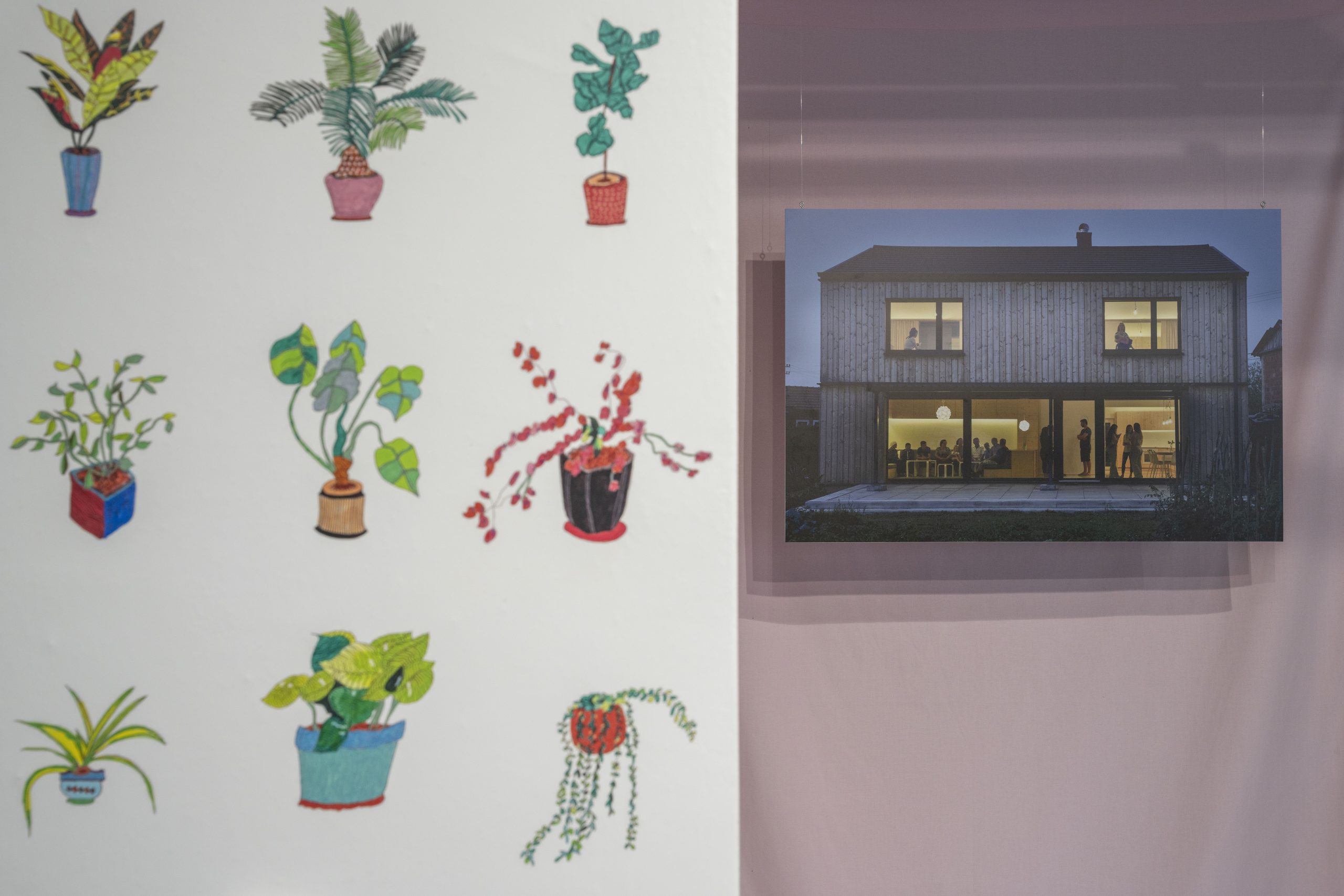
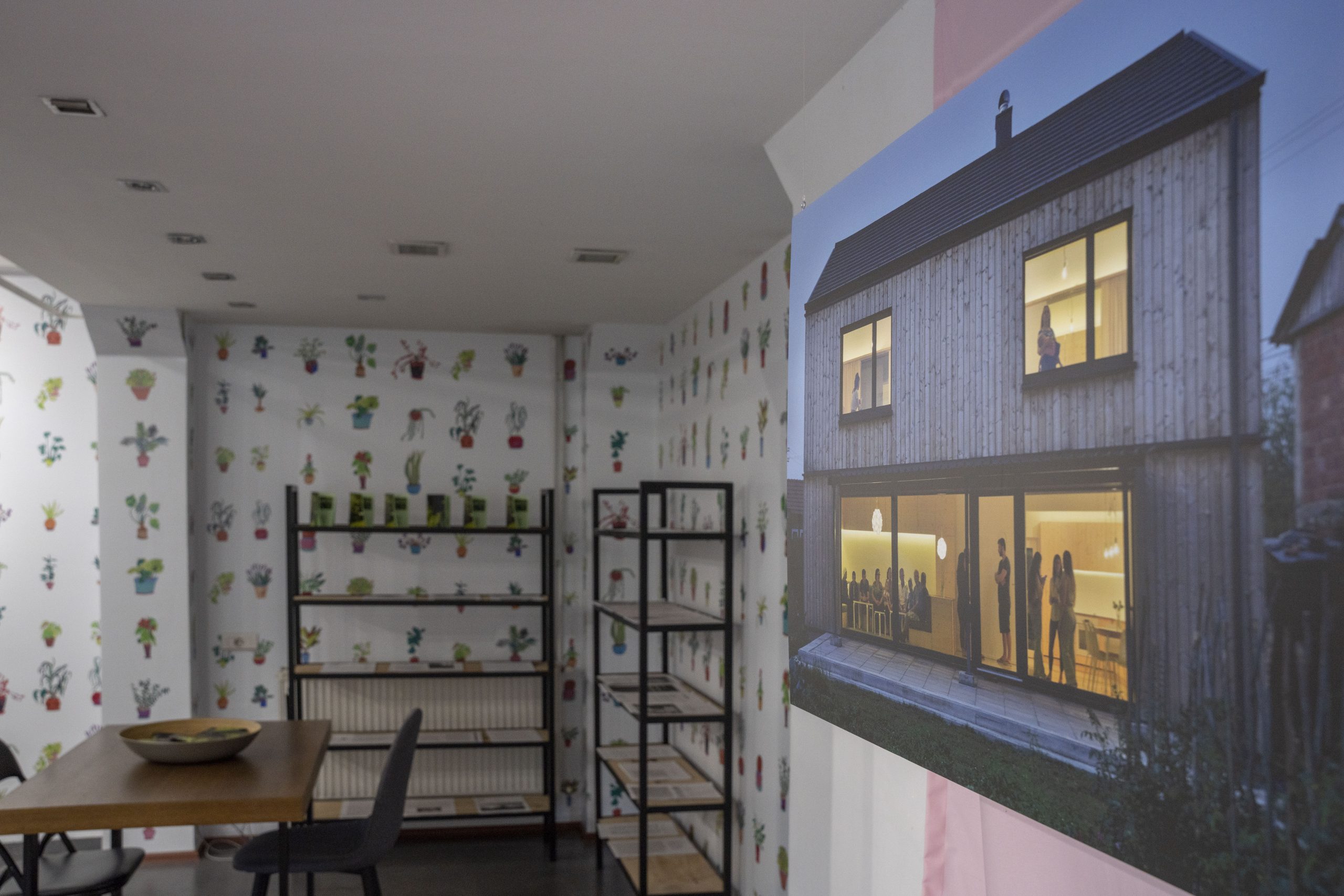
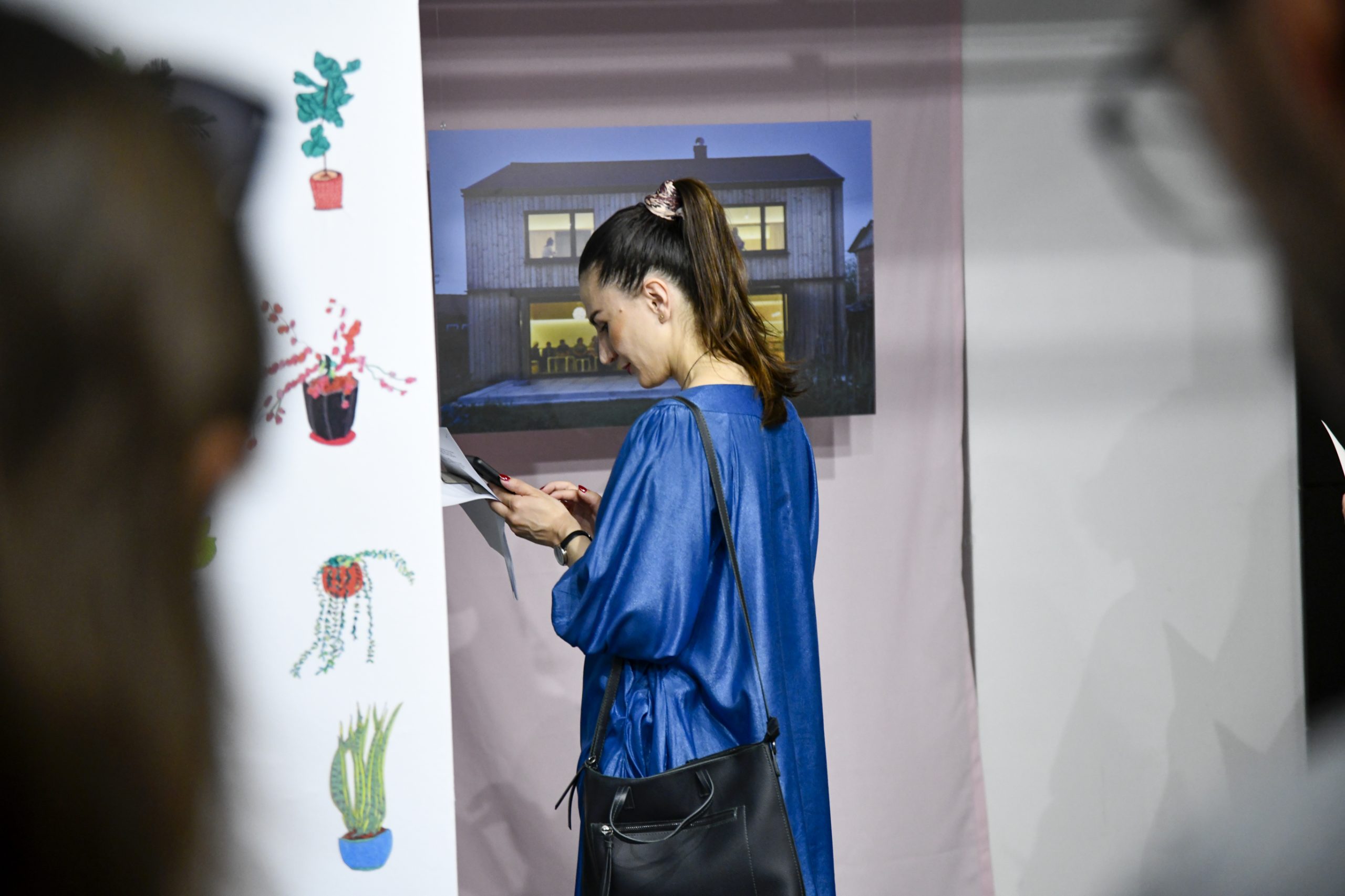
Brilant Pireva (born 1993) is an artist living and working in Prishtina, Kosovo. He works with poetry, video, music and digital painting. His work explores mythology, religion and failure. His practice involves daily public life, improvisational video artworks about public space, ongoing still life studies of “background objects” such as food, waste, public notes, etc.
Splinter is a series of digital drawings developed on analog film. This technique is unique to Pireva, whereby digital hand drawings are light-transferred onto an analog format, in this case a celluloid film, and then developed. This process of “analogization” goes counter to the dominant paradigm of digitalization that defines contemporary modes of communication and arts. The speculative works attempt to render and make manifest the ideal forms of emotion and thought we are faced with today by fossilizing them in film. While visual culture is often misleading, creating different worlds and bubbles through algorithms and the portrayal of differing ideologies, Pireva attempts to cut through with intuitive and speculative forms that aim for a plane of affect that is buried deeper than where ideology operates.
The series is coupled with the short story “The Bridge and the Cage,” which explores the inexorable link between humanity’s fate and its ecology, its home. You are invited to take a copy, and even speculate on its continuation.
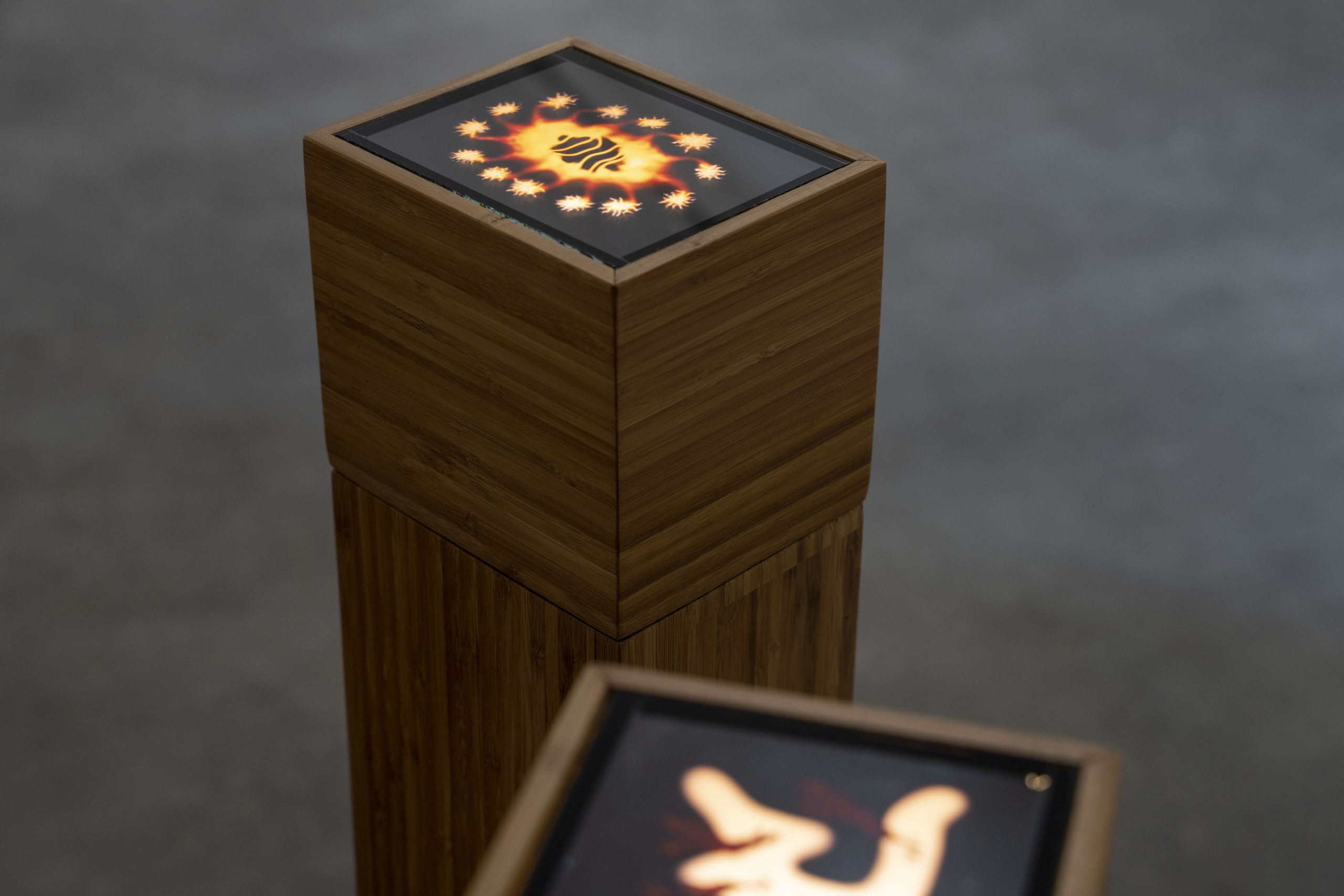
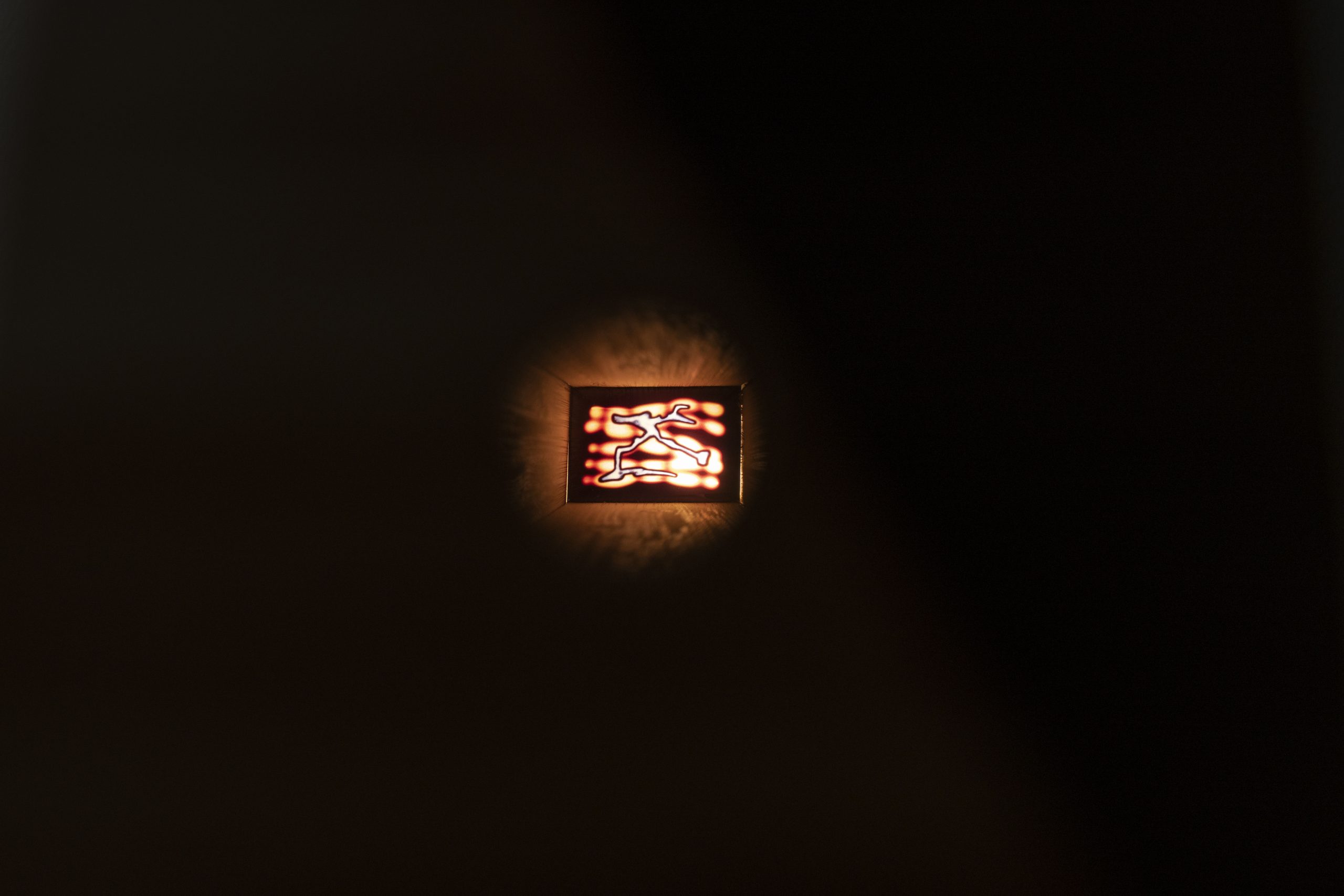
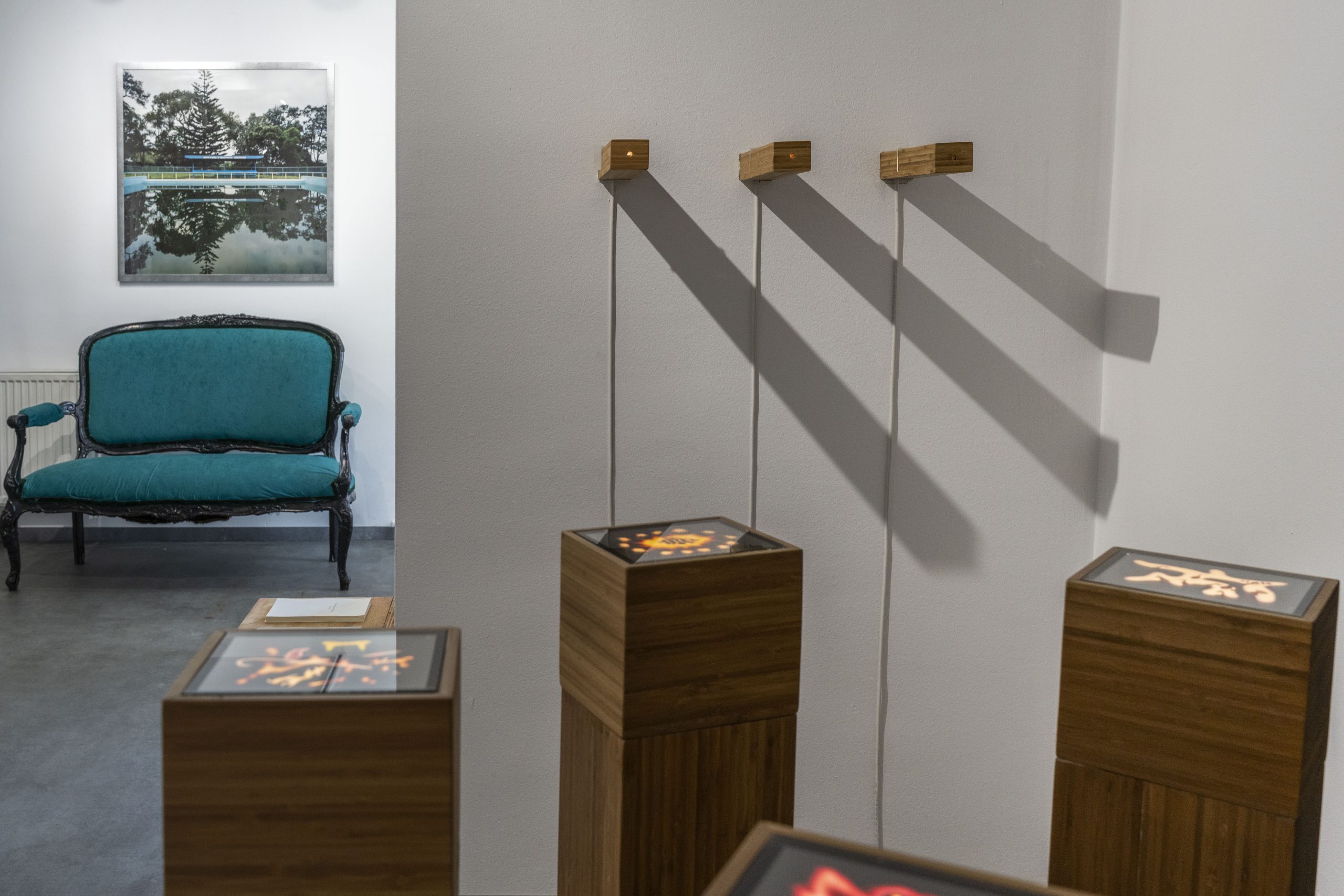
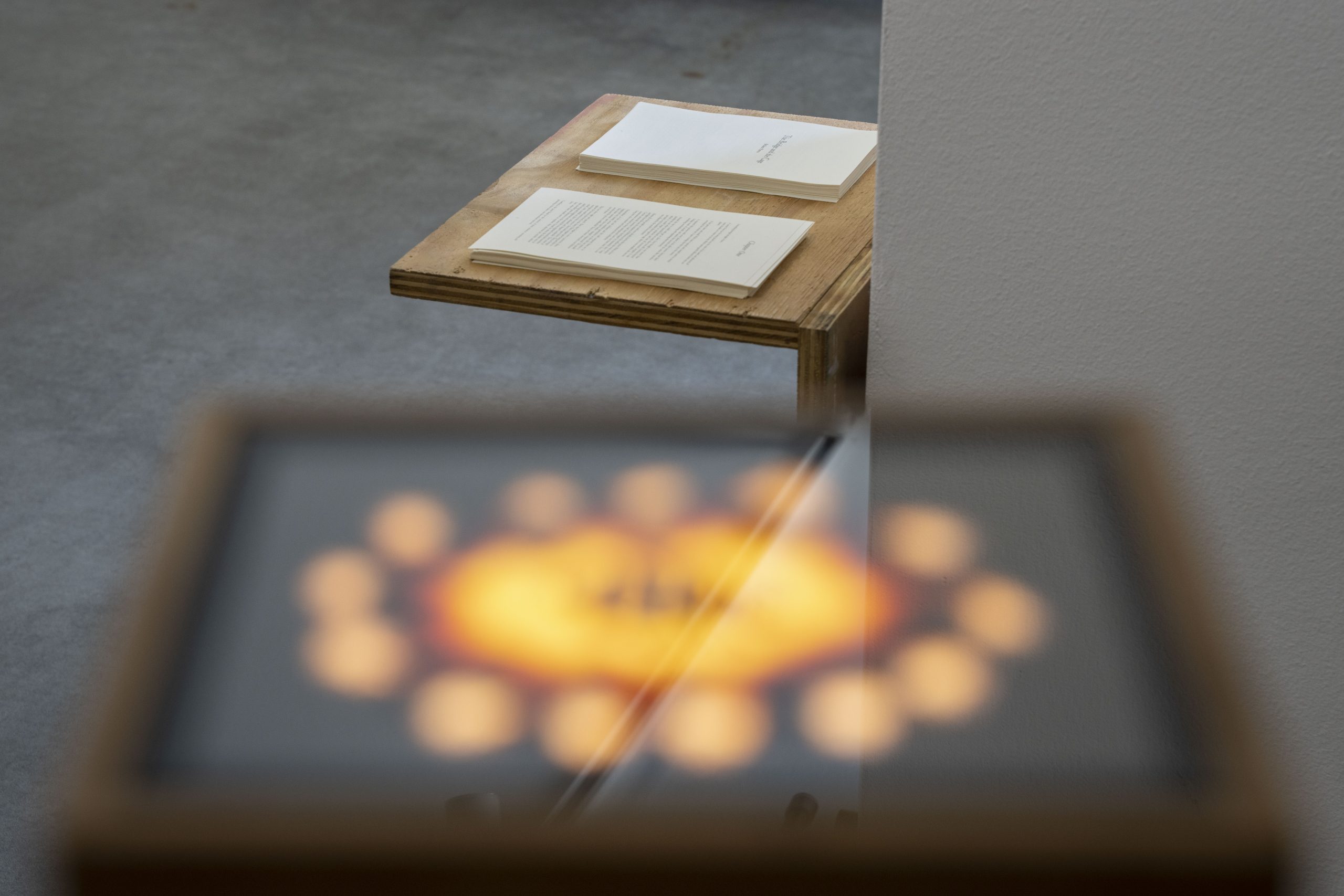
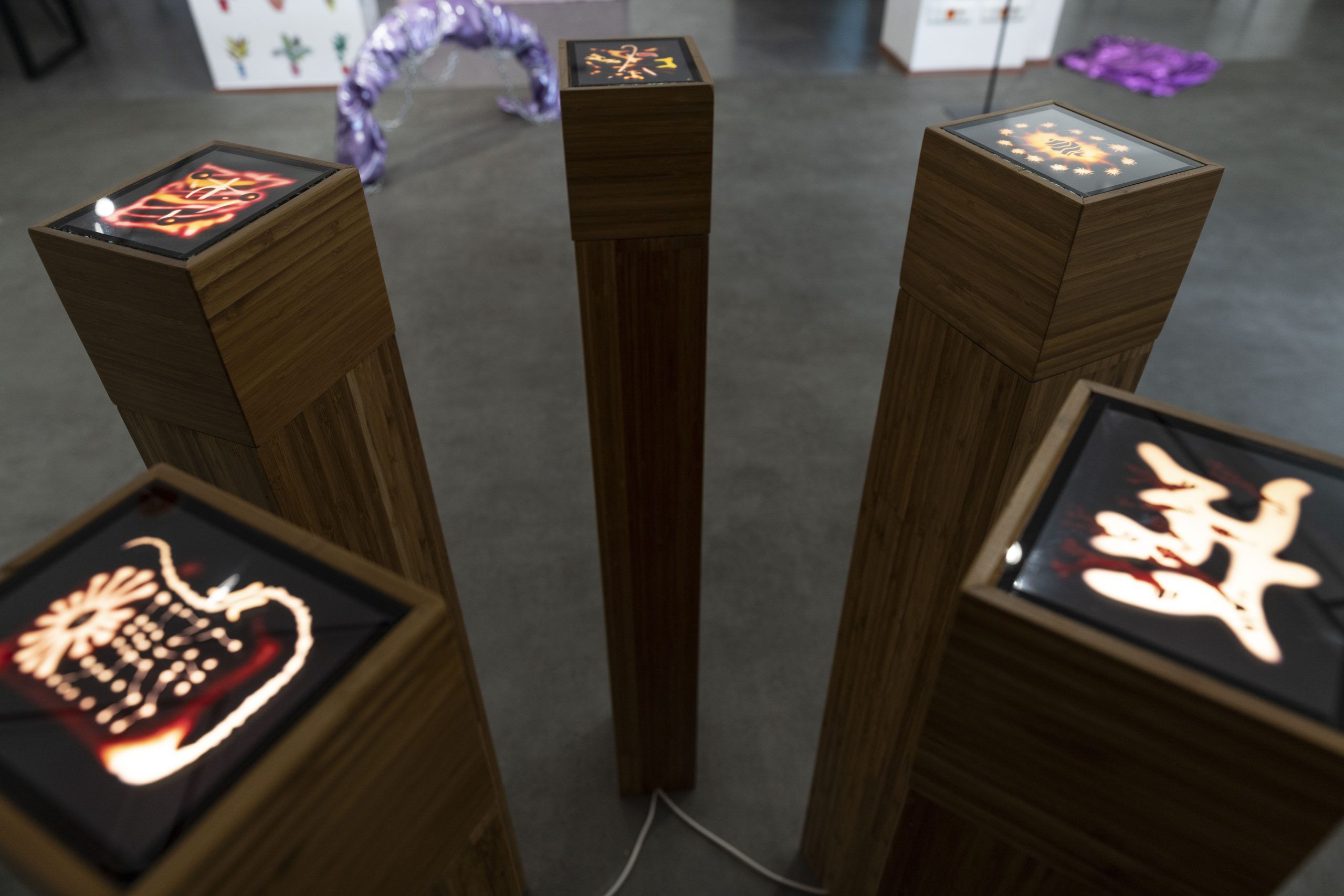

Most of the furniture in the exhibition are objects that have been borrowed from their original homes, still-functioning institutions with diverse histories.
The green velvet sofa belongs to Kosovo’s National Theater. This seat has graced the stage in a wide variety of theatrical productions. The blue velvet chairs from The Grand Hotel, representing a time of unique product designs imagined for a jewel of the city center. They have been lent to us by the Kosovo Privatization Agency. The shelves belong to the Centre for Narrative Practice, a new institution formed during Manifesta 14 Prishtina. They come from the old Hivzi Sylejmani Library and will spark memories for generations of Prishtina residents who wandered the aisles of books as children. The shelves are the result of an upcycling project that student and young architects enacted during Manifesta, under the organization of Cultural Heritage without Borders Kosova. The gray couch in the screening space is from K2.0’s offices.
These objects, generously lent for the exhibition, give us more than decorative furniture, they allow us to access the spirit of how these pieces of furniture come from different social and historical moments, while existing in close geographic proximity.
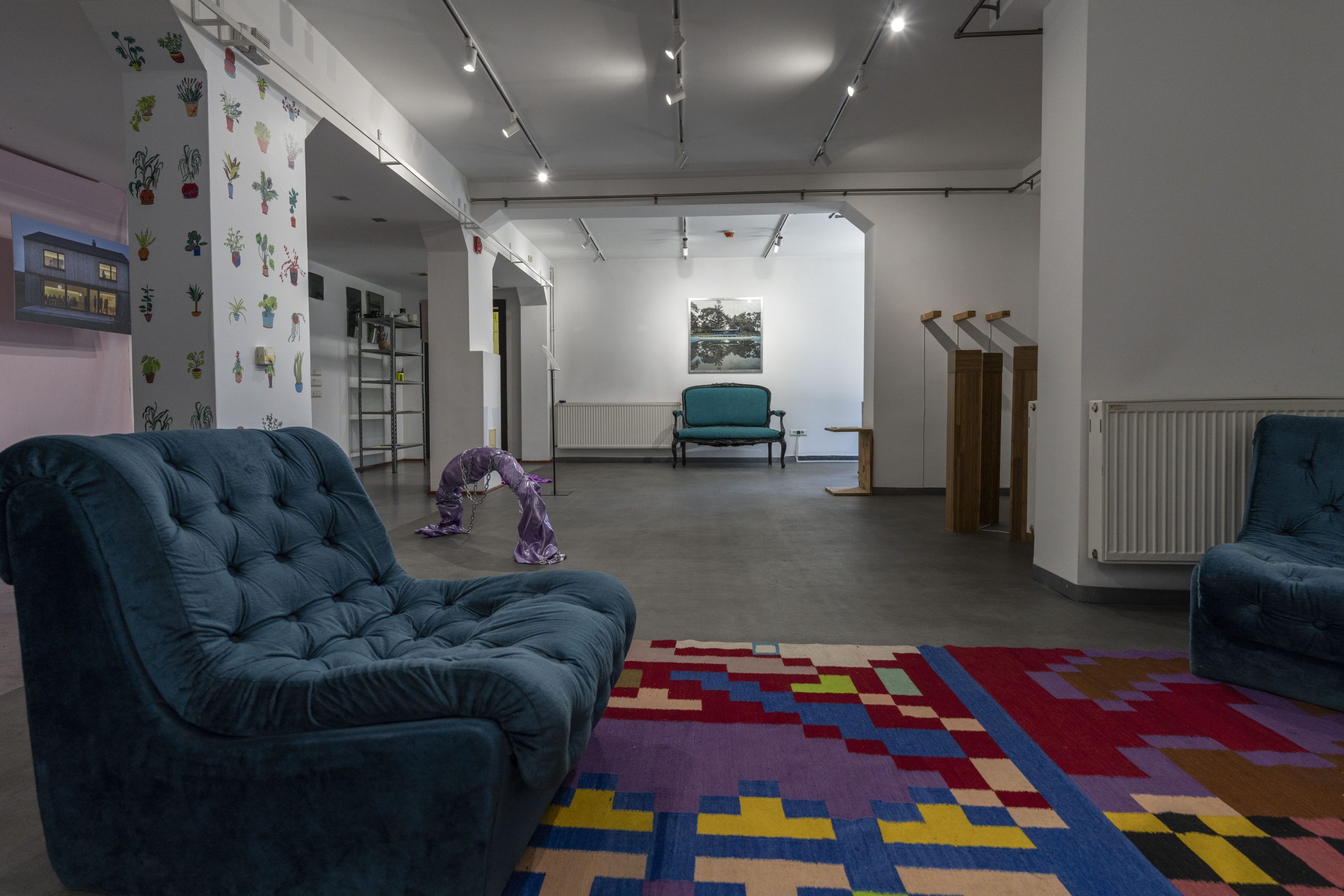
The images of our sun, the nebulas and other glimpses of the universe, with the accompaniment of ambient sounds, creates a space for reflecting on our place in the universe. If the cosmos had ears to hear it, this is what the Earth would sound like. Lie down and enjoy the cosmic sounds of our planet.
The video has been edited by Alban Nuhiu.
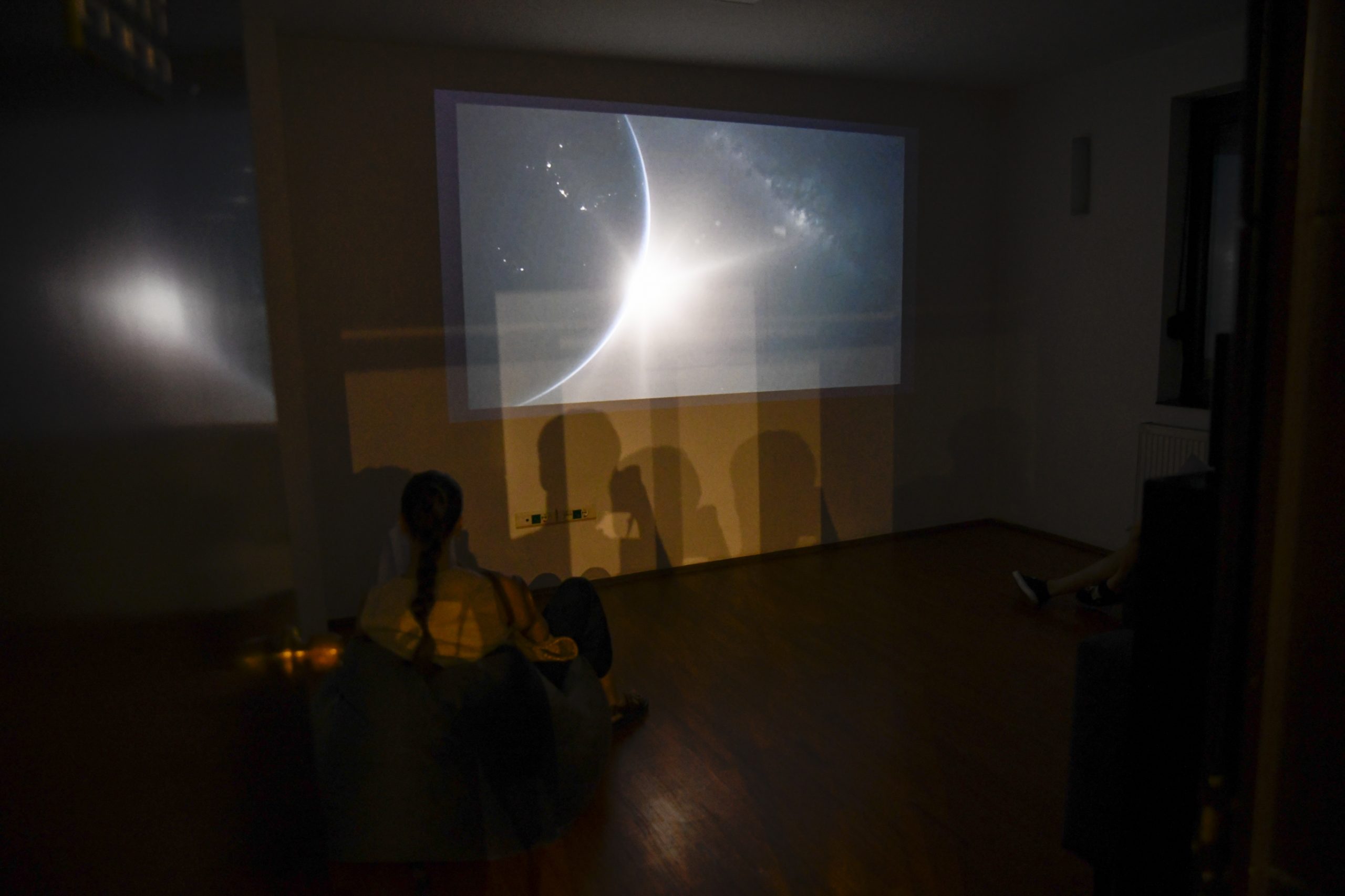

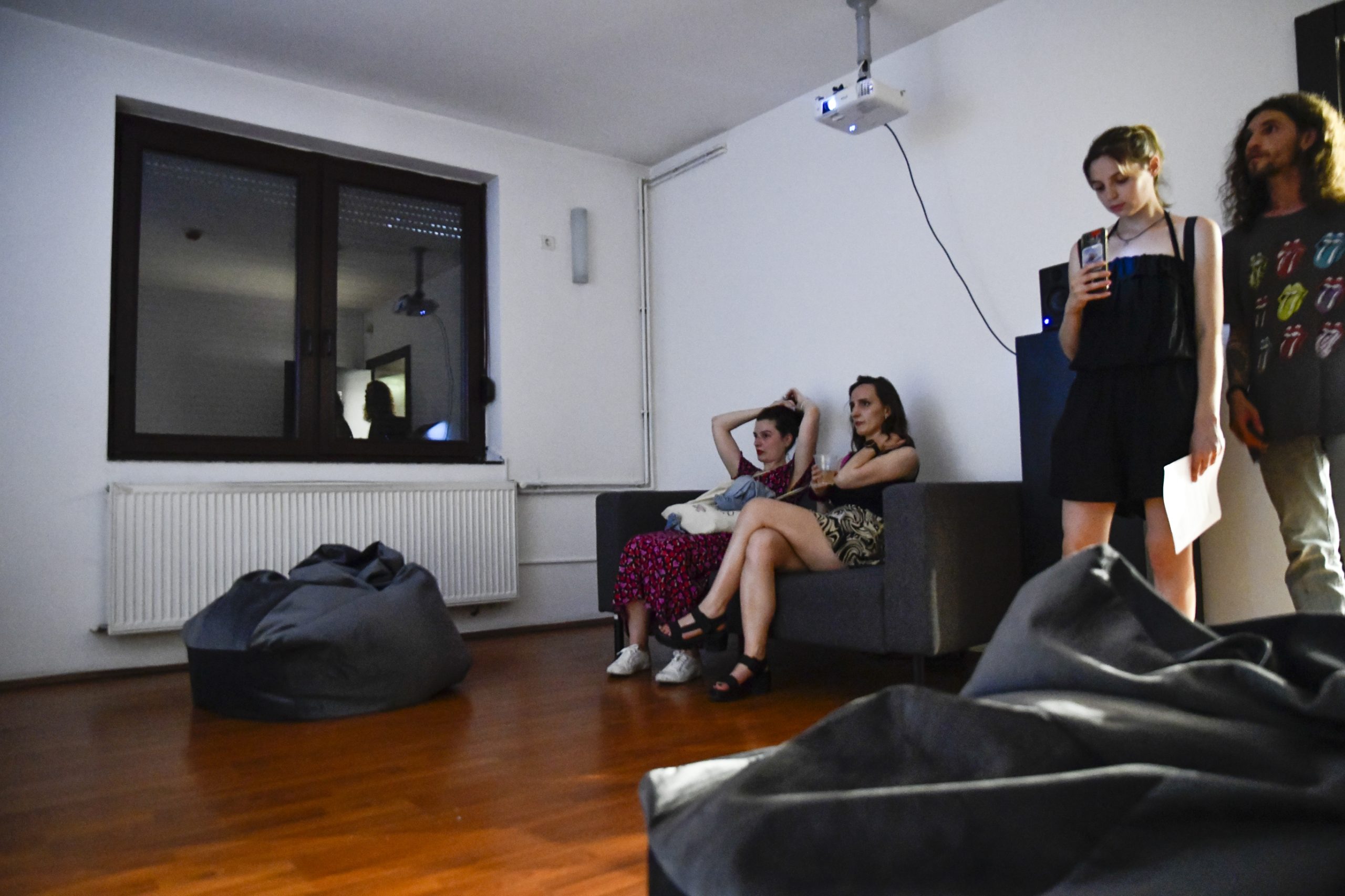
“Housing Chaos in Prishtina,” is a longform article written by Uran Haxha and Halim Kafexholli and featured as part of K2.0’s 2023 Carnival “HOME.” Through personal stories and big picture story-telling, readers get a portrait of the chaotic situation of housing and construction in Prishtina. Starting with the story of Arsim Gllogu, whose family house has been destroyed by newly built high-rise buildings, the article zooms out and traverses the neighborhoods of Prishtina that are rapidly being transformed by new construction.
Take a postcard with quotes from the article home with you!
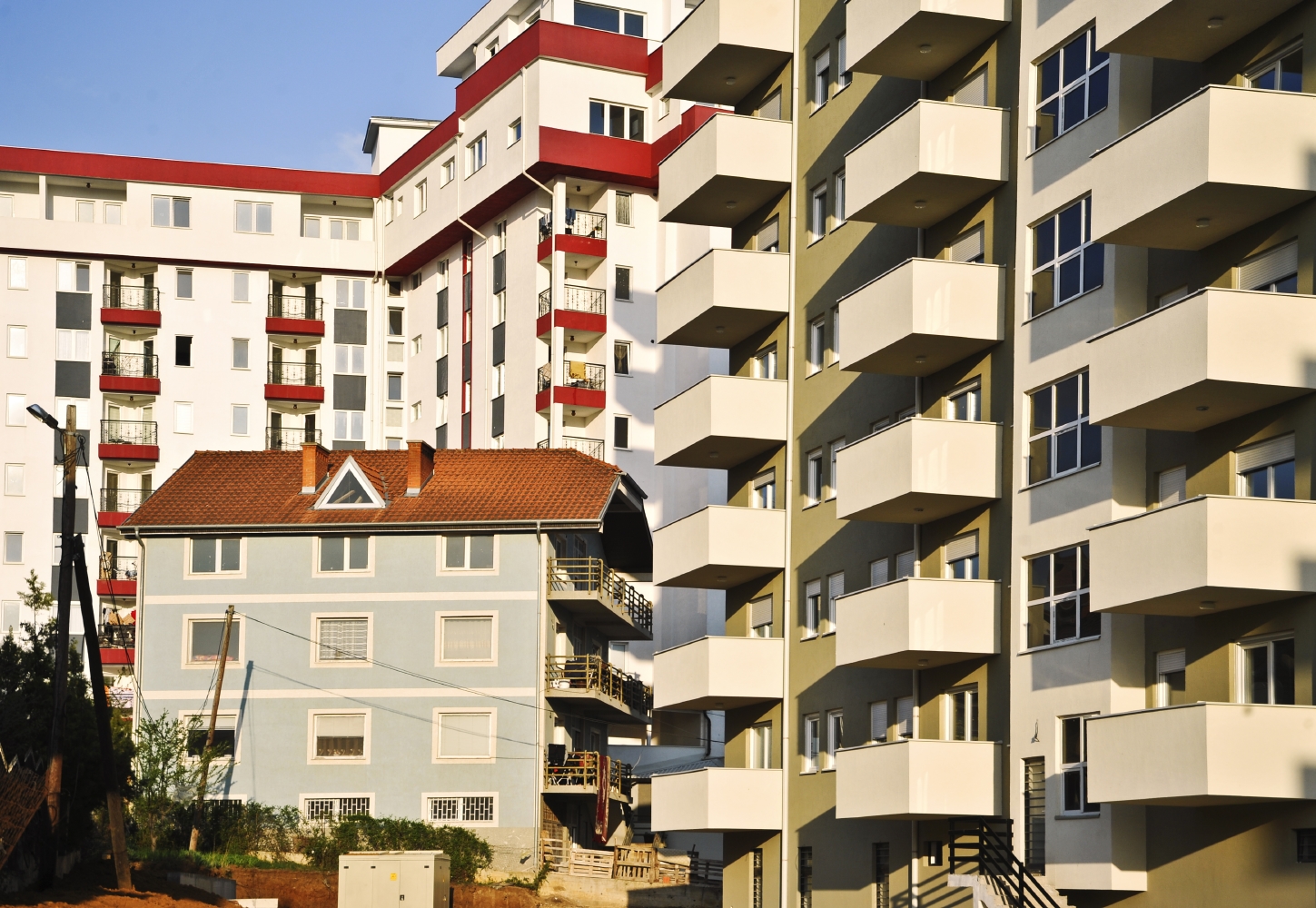
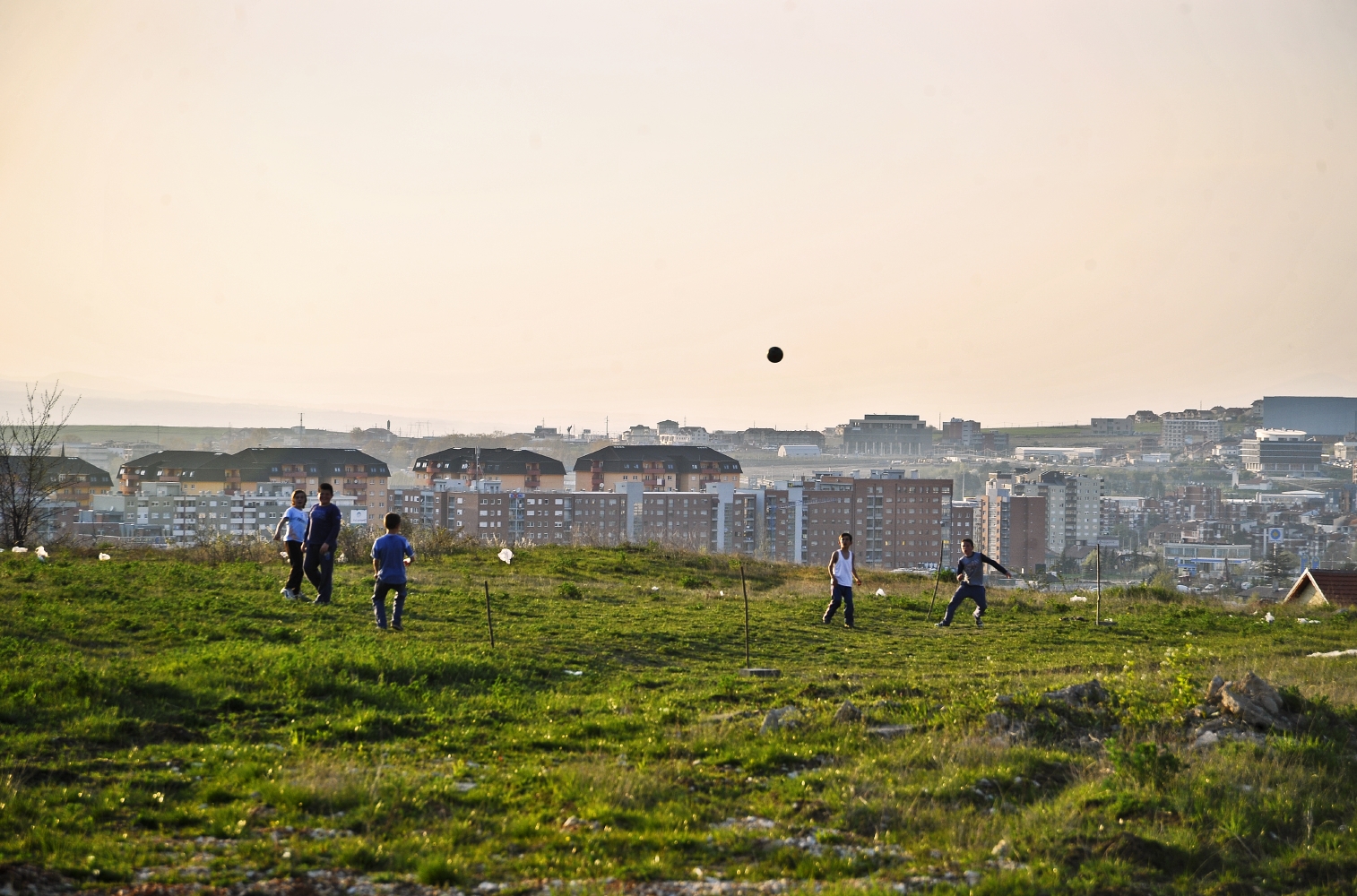
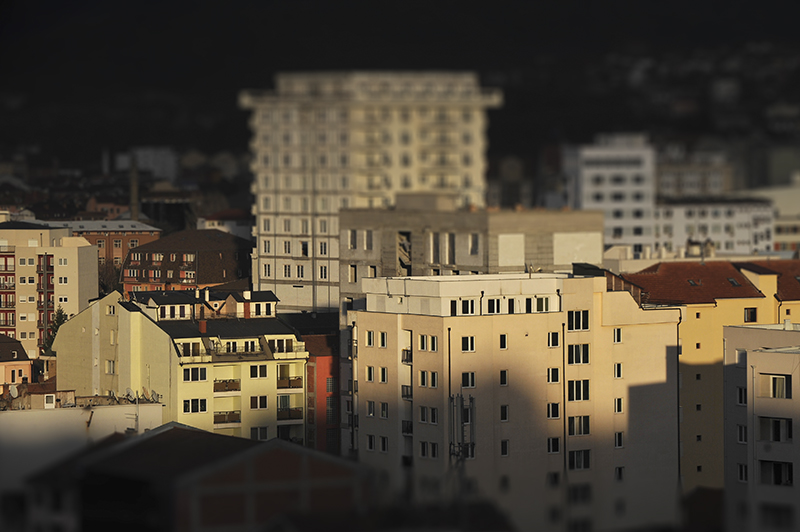
A corner of this intervention is filled with a copy of selected photocopied articles and papers. It’s reminiscent of the student experience, when buying original copies is too expensive for most and universities provide selected chapters and articles to be unofficially printed (despite potential copyright violations). This library too shows prints of different chapters and articles on an A4 Print that you are invited to take and read. You can find a full list of the articles by the library.
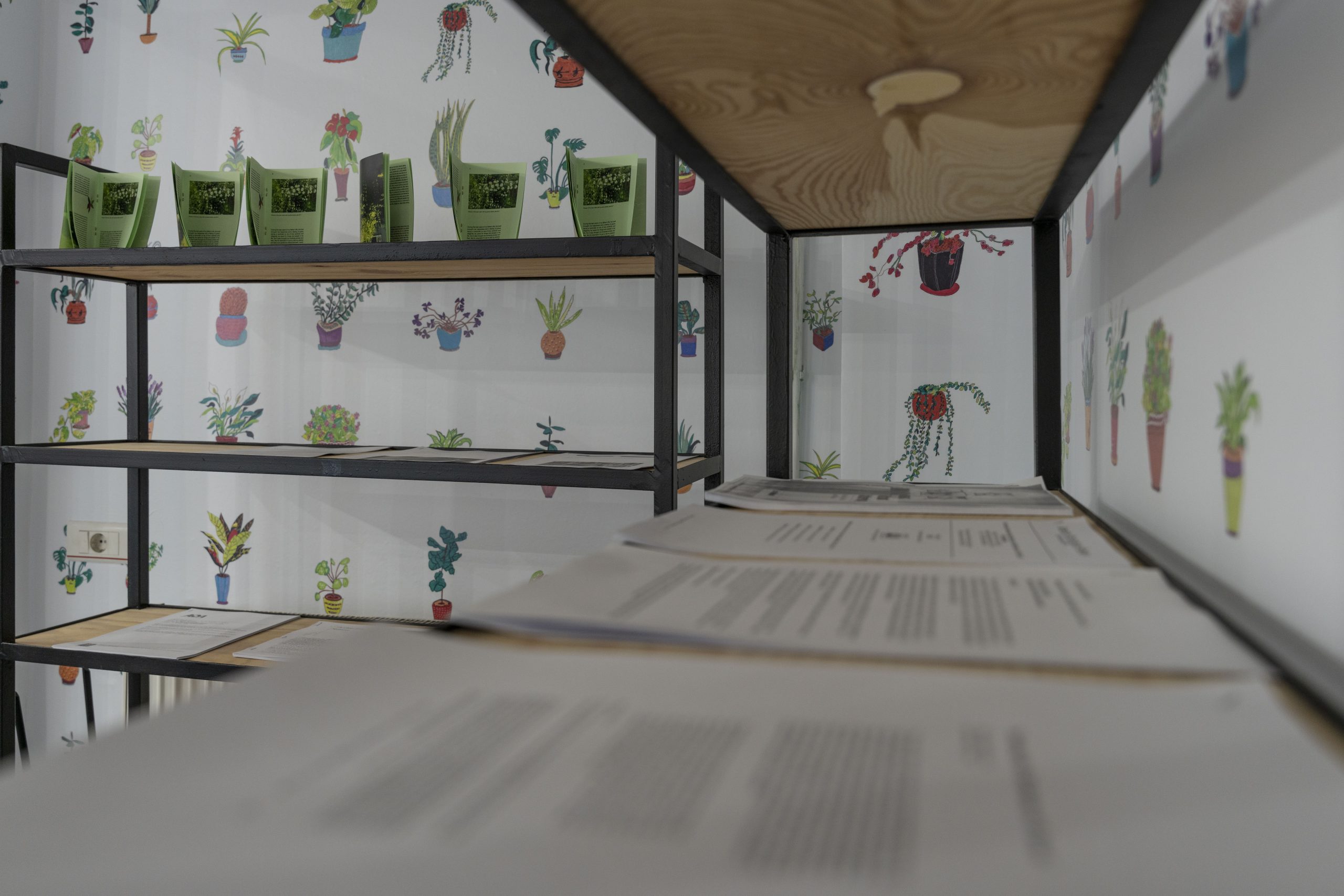
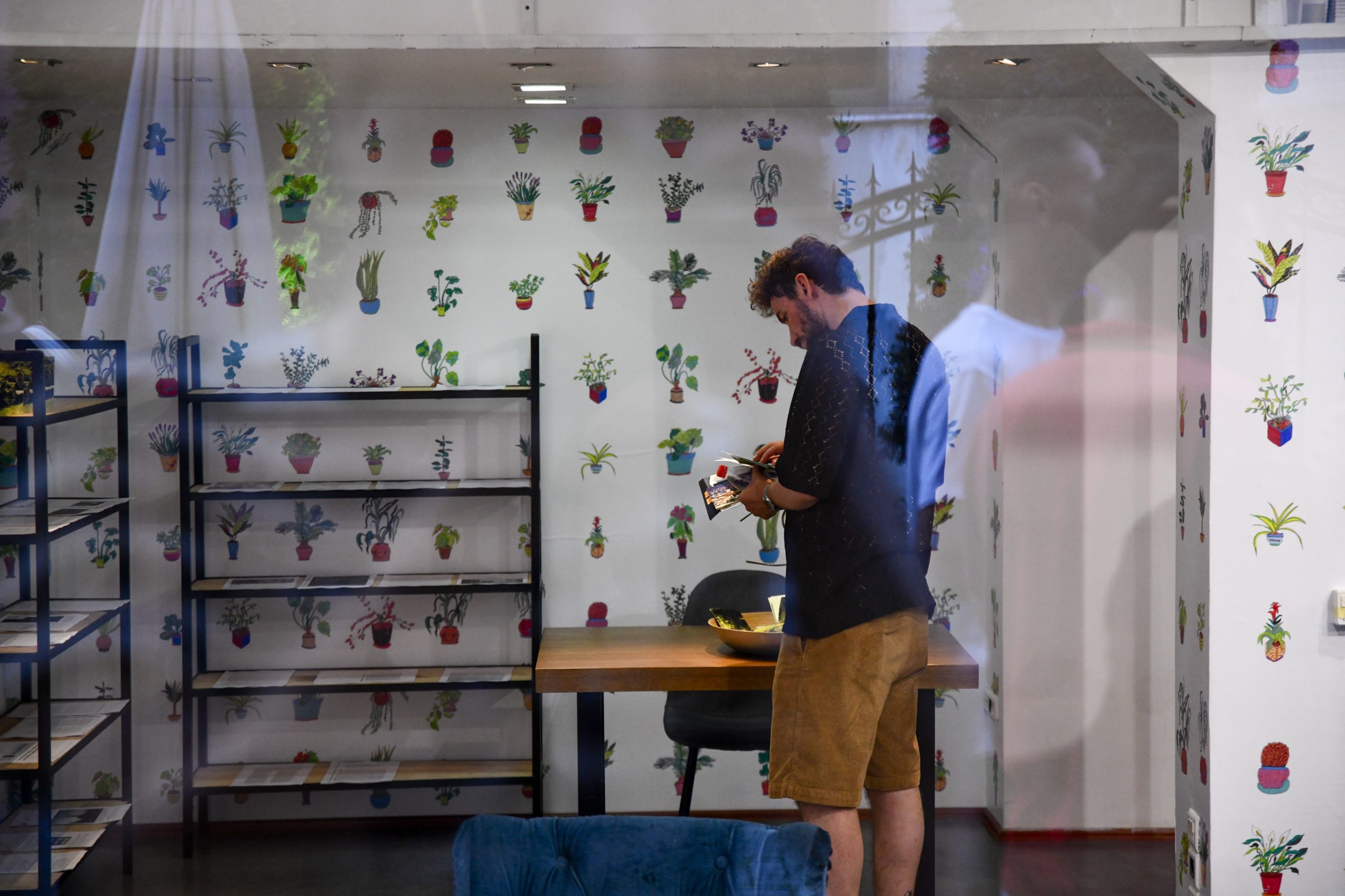
We would like to express our gratitude to Foundation 17, The National Theater of Kosovo, The Centre for Narrative Practice, the Privatization Agency of Kosovo and The Grand Hotel for their generous support in this exhibition.
Credits:
This exhibition has been commissioned by Kosovo 2.0 for our HOME carnival
Production Lead: Lendita Idrizi (Leni Productions)
Exhibition Technician/Production Advisor: Skender Xhukolli
Producer: Fatlum Idrizi (Leni Productions)
Set Design: Dardan Zhegrova
- This story was originally written in English.

